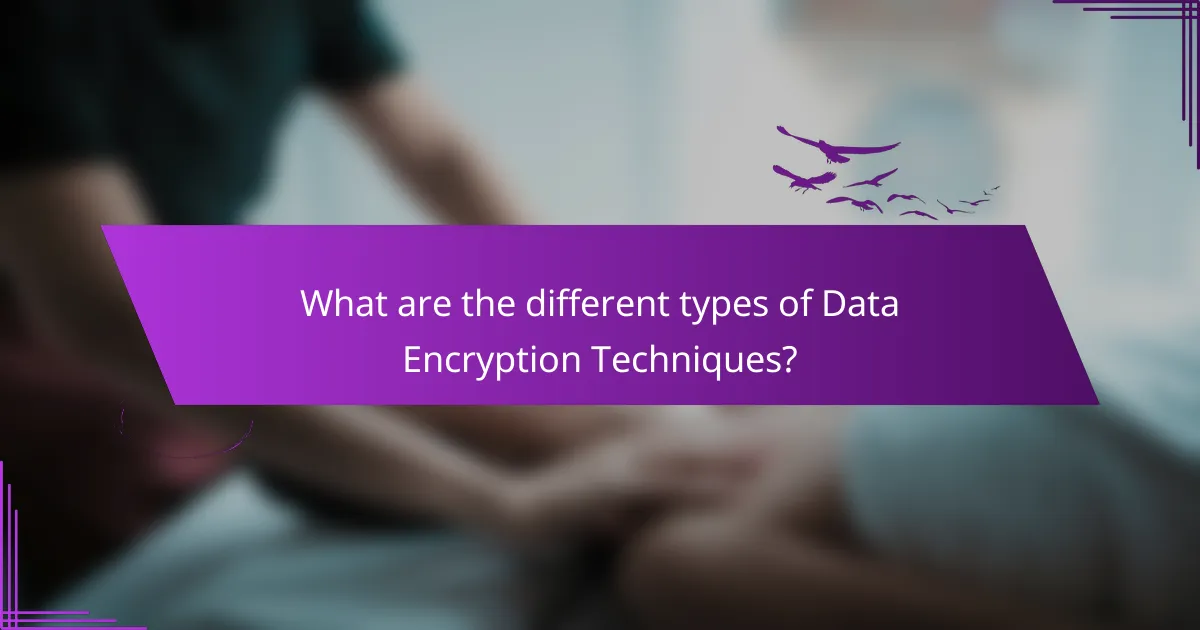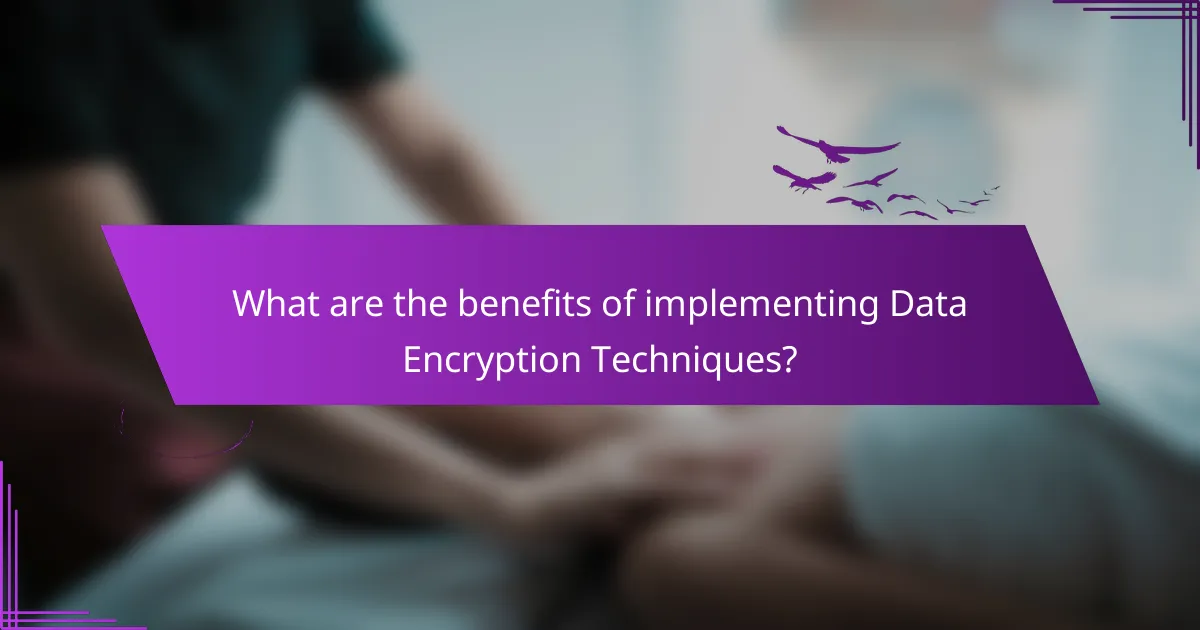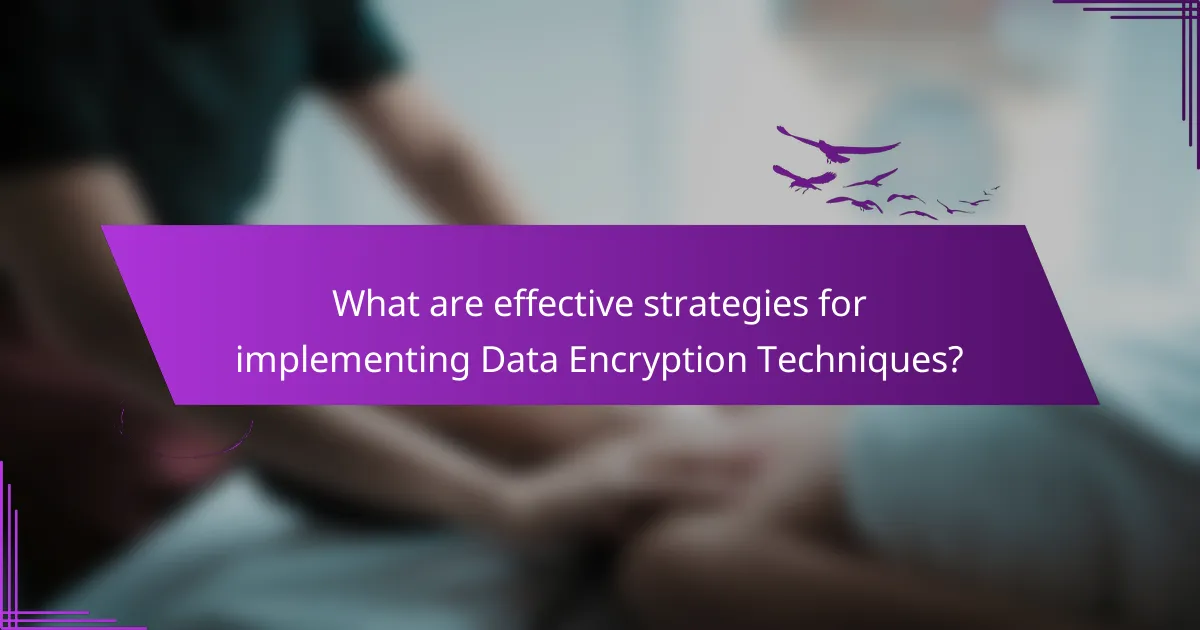
What are Data Encryption Techniques?
Data encryption techniques are methods used to secure data by transforming it into a format that is unreadable without a decryption key. These techniques include symmetric encryption, where the same key is used for both encryption and decryption, and asymmetric encryption, which utilizes a pair of keys—a public key for encryption and a private key for decryption. Common algorithms include AES (Advanced Encryption Standard) for symmetric encryption and RSA (Rivest-Shamir-Adleman) for asymmetric encryption. The effectiveness of these techniques is evident in their widespread use for protecting sensitive information in various applications, including online banking and secure communications. According to the National Institute of Standards and Technology (NIST), AES is widely adopted due to its strong security and efficiency, making it the encryption standard for federal use.
How do Data Encryption Techniques function?
Data encryption techniques function by transforming readable data into an unreadable format. This process is achieved using algorithms that apply a key to the data. The key is a string of characters that determines the output of the encryption. Common encryption algorithms include AES (Advanced Encryption Standard) and RSA (Rivest-Shamir-Adleman).
When data is encrypted, it becomes ciphertext, which can only be converted back to its original form by using the correct key. This ensures that unauthorized users cannot access the original data. Encryption is widely used in securing sensitive information, such as financial transactions and personal data.
According to the National Institute of Standards and Technology (NIST), effective encryption techniques are essential for data protection in various industries. The implementation of these techniques helps maintain confidentiality and integrity of data.
What are the key components of Data Encryption Techniques?
The key components of data encryption techniques are algorithms, keys, and protocols. Algorithms are mathematical functions used to encrypt and decrypt data. Common algorithms include AES, RSA, and DES. Keys are unique strings of data used in the encryption process. The security of encrypted data relies heavily on the strength and secrecy of the keys. Protocols define the rules for how encryption is applied in communication. Examples of protocols include SSL/TLS and HTTPS. Together, these components ensure the confidentiality and integrity of data during transmission and storage.
How do different algorithms impact Data Encryption Techniques?
Different algorithms significantly impact data encryption techniques by determining the strength and efficiency of the encryption. Algorithms like AES, RSA, and DES vary in key length, computational complexity, and security level. AES (Advanced Encryption Standard) uses symmetric key encryption, providing high security with shorter processing times. RSA (Rivest-Shamir-Adleman) employs asymmetric encryption, which is secure but slower due to larger key sizes. DES (Data Encryption Standard) is now considered outdated, as its shorter key length makes it vulnerable to attacks. The choice of algorithm affects data confidentiality, integrity, and performance, influencing how effectively sensitive information is protected. For instance, AES is widely adopted for its balance of security and speed, making it suitable for various applications.
Why are Data Encryption Techniques important?
Data encryption techniques are important because they protect sensitive information from unauthorized access. Encryption transforms data into a coded format that can only be read by those who possess the decryption key. This is crucial in safeguarding personal, financial, and confidential business data. According to a 2021 report by IBM, 95% of data breaches involve human error, emphasizing the need for encryption as a preventive measure. Furthermore, encryption helps organizations comply with regulations like GDPR and HIPAA, which mandate data protection. Effective encryption techniques can also enhance customer trust, as consumers are more likely to engage with companies that prioritize data security.
What risks do Data Encryption Techniques mitigate?
Data encryption techniques mitigate several risks associated with data security. They primarily protect against unauthorized access to sensitive information. Encryption ensures that even if data is intercepted, it remains unreadable without the decryption key. This significantly reduces the risk of data breaches and identity theft. Additionally, encryption helps in mitigating risks related to data integrity. It ensures that data is not altered during transmission. Furthermore, encryption can protect against insider threats by restricting access to authorized users only. According to a report by the Ponemon Institute, organizations that implement encryption experience 50% fewer data breaches. This statistic underscores the effectiveness of encryption in enhancing data security.
How do Data Encryption Techniques enhance data security?
Data encryption techniques enhance data security by converting information into a coded format. This process ensures that only authorized users can access the data. Encryption protects sensitive information from unauthorized access and breaches. It employs algorithms to transform plaintext into ciphertext, making it unreadable without a decryption key. For example, AES (Advanced Encryption Standard) is a widely used encryption method. According to the National Institute of Standards and Technology (NIST), AES is considered secure and efficient for protecting data. Additionally, encryption can safeguard data during transmission over networks. This reduces the risk of interception by malicious actors. Overall, data encryption is a critical component of modern cybersecurity strategies.

What are the different types of Data Encryption Techniques?
There are several types of data encryption techniques. The primary types include symmetric encryption, asymmetric encryption, and hashing.
Symmetric encryption uses a single key for both encryption and decryption. Advanced Encryption Standard (AES) is a widely used symmetric encryption algorithm. Asymmetric encryption employs a pair of keys, a public key for encryption and a private key for decryption. RSA (Rivest-Shamir-Adleman) is a well-known asymmetric encryption method.
Hashing is a technique that converts data into a fixed-size string of characters, which is typically a hash value. Common hashing algorithms include SHA-256 and MD5. Each type of encryption serves different purposes and offers varying levels of security.
What are symmetric and asymmetric encryption methods?
Symmetric encryption uses the same key for both encryption and decryption. This method is efficient and faster than asymmetric encryption. Common algorithms include AES and DES. Asymmetric encryption employs a pair of keys: a public key for encryption and a private key for decryption. This method enhances security and is widely used in secure communications. Notable algorithms include RSA and ECC. Symmetric encryption is suitable for large data volumes, while asymmetric encryption is better for secure key exchanges.
How do symmetric encryption methods work?
Symmetric encryption methods work by using the same key for both encryption and decryption. This means that the sender and receiver must share a secret key before communication. The encryption process transforms plaintext into ciphertext using the shared key. The decryption process reverses this transformation, converting ciphertext back to plaintext with the same key. Symmetric encryption is generally faster than asymmetric encryption due to its simpler mathematical operations. Common symmetric encryption algorithms include AES, DES, and Blowfish. According to NIST, AES is widely used and considered secure for various applications.
What are the advantages and disadvantages of asymmetric encryption?
Asymmetric encryption has several advantages and disadvantages. One advantage is enhanced security. It uses a pair of keys, a public key for encryption and a private key for decryption. This separation ensures that even if the public key is exposed, the private key remains secure. Another advantage is that it facilitates secure key exchange. Users can share their public keys openly without compromising their private keys. Additionally, asymmetric encryption supports digital signatures, providing authentication and integrity for messages.
However, there are disadvantages to asymmetric encryption. One significant disadvantage is slower performance compared to symmetric encryption. The complex mathematical operations involved in asymmetric algorithms make them less efficient for encrypting large amounts of data. Another disadvantage is the management of keys. Users must securely manage and store their private keys, which can be challenging. Furthermore, if a private key is lost or compromised, all data encrypted with the corresponding public key becomes inaccessible or insecure.
What is end-to-end encryption?
End-to-end encryption is a method of data transmission that ensures only the communicating users can read the messages. In this technique, data is encrypted on the sender’s device and only decrypted on the recipient’s device. This means that intermediaries, including service providers, cannot access the plaintext data. End-to-end encryption is commonly used in messaging apps like WhatsApp and Signal. It relies on cryptographic keys that are known only to the sender and recipient. This approach enhances privacy and security by protecting sensitive information from unauthorized access. Studies have shown that end-to-end encryption significantly reduces the risk of data breaches.
How does end-to-end encryption protect user data?
End-to-end encryption protects user data by ensuring that only the communicating users can read the messages. In this method, data is encrypted on the sender’s device and only decrypted on the recipient’s device. This means that intermediaries, such as service providers, cannot access the content of the messages. The encryption keys are only held by the users, preventing unauthorized access. According to a 2020 report by the Electronic Frontier Foundation, end-to-end encryption significantly enhances privacy and security in digital communications. This method is widely used in messaging apps like WhatsApp and Signal, which implement strong encryption protocols to safeguard user data.
What are the challenges associated with implementing end-to-end encryption?
Implementing end-to-end encryption presents several challenges. One major challenge is the complexity of key management. Users must securely generate, store, and share encryption keys. This process can be confusing and error-prone. Another challenge is ensuring compatibility across different platforms and devices. Not all systems support the same encryption standards. Usability is also a significant issue. Many users may find encrypted communication tools difficult to use. Additionally, there are regulatory and legal concerns. Some jurisdictions require access to encrypted data for law enforcement purposes. This can create conflicts between privacy and compliance. Lastly, performance can be affected. Encryption and decryption processes can introduce latency in communications. These challenges must be addressed to implement end-to-end encryption effectively.

What are the benefits of implementing Data Encryption Techniques?
Implementing data encryption techniques provides several key benefits. First, encryption enhances data security by converting information into an unreadable format. This protects sensitive data from unauthorized access. Second, encryption helps maintain data integrity. It ensures that information remains unchanged during transmission. Third, it fosters compliance with regulations. Many laws require organizations to protect sensitive data through encryption. Fourth, encryption builds customer trust. Clients are more likely to engage with businesses that prioritize data protection. Finally, encryption mitigates the risk of data breaches. According to a 2021 report by IBM, organizations with encryption experienced 60% lower costs related to data breaches.
How do Data Encryption Techniques protect sensitive information?
Data encryption techniques protect sensitive information by converting it into an unreadable format. This process uses algorithms to scramble data, making it accessible only to those with the correct decryption key. For instance, Advanced Encryption Standard (AES) is widely used for securing data in transit and at rest. When data is encrypted, unauthorized users cannot interpret it, even if they gain access. According to a study by the National Institute of Standards and Technology (NIST), encryption significantly reduces the risk of data breaches. In 2020, organizations that employed encryption reported 30% fewer incidents of data theft. Thus, data encryption serves as a critical safeguard for protecting sensitive information.
What specific types of data benefit from encryption?
Sensitive personal information benefits from encryption. This includes data such as Social Security numbers and financial account details. Health records also require encryption to protect patient privacy. Business trade secrets and intellectual property are critical data types that should be encrypted. Communication data, like emails and messages, benefit from encryption to ensure confidentiality. Regulatory compliance often mandates the encryption of specific data types. For example, the Health Insurance Portability and Accountability Act (HIPAA) requires encryption for health data. Encryption safeguards data against unauthorized access and breaches.
How do Data Encryption Techniques comply with data protection regulations?
Data encryption techniques comply with data protection regulations by ensuring that sensitive information is securely processed and stored. Regulations like GDPR and HIPAA mandate that personal data must be protected against unauthorized access. Encryption transforms data into an unreadable format, requiring a decryption key for access. This process safeguards data during transmission and storage. Compliance is further demonstrated through encryption standards such as AES and RSA, which are recognized for their security. Additionally, encryption helps organizations minimize the risk of data breaches, aligning with regulatory requirements for data integrity and confidentiality. Regular audits and assessments of encryption practices also ensure ongoing compliance with evolving regulations.
What are the cost implications of Data Encryption Techniques?
Data encryption techniques can incur significant costs. These costs arise from software acquisition, hardware upgrades, and personnel training. Organizations must invest in encryption solutions, which can range from hundreds to thousands of dollars. Additionally, ongoing maintenance and support can add to these expenses. Performance impacts may require enhanced hardware, further increasing costs. Compliance with regulations may also necessitate additional investment in encryption. A study by the Ponemon Institute reported that data breaches involving unencrypted data cost companies an average of $3.86 million. Therefore, while encryption provides security benefits, it also presents notable financial implications.
How can organizations justify the investment in Data Encryption Techniques?
Organizations can justify the investment in Data Encryption Techniques by highlighting their role in protecting sensitive information. Data encryption safeguards against unauthorized access and data breaches. According to a study by IBM, the average cost of a data breach in 2021 was $4.24 million. Investing in encryption reduces this risk significantly. Additionally, encryption helps organizations comply with regulations like GDPR and HIPAA. Non-compliance can result in hefty fines. Furthermore, encryption enhances customer trust and loyalty by ensuring data privacy. A secure environment can lead to increased business opportunities. Overall, the financial and reputational benefits of data encryption outweigh the initial investment costs.
What are the potential cost savings from preventing data breaches?
Preventing data breaches can lead to significant cost savings for organizations. The average cost of a data breach in 2023 was approximately $4.45 million, according to the IBM Cost of a Data Breach Report. By implementing preventative measures, such as data encryption, companies can reduce the likelihood of breaches occurring. This can lower potential financial losses related to legal fees, regulatory fines, and customer compensation. Additionally, organizations can save on recovery costs and reputational damage that often follows a breach. Investing in cybersecurity measures can yield a return on investment by avoiding these substantial costs.

What are effective strategies for implementing Data Encryption Techniques?
Effective strategies for implementing data encryption techniques include assessing data sensitivity, selecting appropriate encryption algorithms, and ensuring key management. Organizations should first identify which data requires encryption based on its sensitivity level. Common algorithms include AES and RSA, which are widely recognized for their security. Proper key management is crucial; it involves generating, distributing, and storing encryption keys securely. Regularly updating encryption protocols helps protect against emerging threats. Additionally, training employees on encryption practices enhances overall security. Compliance with regulations such as GDPR or HIPAA ensures that encryption strategies meet legal requirements.
How should organizations assess their encryption needs?
Organizations should assess their encryption needs by evaluating data sensitivity and regulatory requirements. They must identify critical data that requires protection. This includes personal information, financial records, and intellectual property. Organizations should also consider the potential impact of data breaches. Assessing risks helps determine the level of encryption required. Additionally, they need to review existing security measures and identify gaps. It is essential to involve stakeholders from IT, legal, and compliance departments. Regular assessments ensure encryption strategies remain aligned with evolving threats and regulations.
What factors should be considered when choosing encryption methods?
When choosing encryption methods, several factors must be considered. Key factors include security level, algorithm strength, and performance efficiency. The security level indicates how well the encryption protects data from unauthorized access. Algorithm strength refers to the complexity and robustness of the encryption algorithm used. Performance efficiency measures how quickly the encryption and decryption processes occur without significant delays.
Additionally, compatibility with existing systems is crucial. The chosen method must integrate seamlessly with current technologies. User-friendliness is also important, as complex systems may hinder effective usage. Regulatory compliance is another factor; encryption methods must meet legal standards relevant to the industry.
Cost considerations play a role as well. Budget constraints can limit available options. Finally, scalability is essential for future growth. The encryption method should adapt to increasing data volumes and evolving security threats.
How can organizations evaluate the effectiveness of their encryption strategies?
Organizations can evaluate the effectiveness of their encryption strategies by conducting regular audits and assessments. These evaluations should include testing the encryption algorithms used for vulnerabilities. Organizations should also analyze incident response times to encryption-related breaches. Monitoring access controls and user permissions can identify potential weaknesses. Additionally, organizations should compare their encryption practices against industry standards and compliance requirements. Gathering feedback from stakeholders about encryption usability can provide insights into effectiveness. Using metrics such as data breach incidents post-encryption can quantify success. Finally, employing third-party security assessments can offer an unbiased evaluation of encryption strategies.
What best practices should be followed for Data Encryption Techniques?
Use strong encryption algorithms, such as AES-256, to ensure data security. Regularly update encryption keys to mitigate risks of unauthorized access. Implement encryption at rest and in transit to protect data throughout its lifecycle. Utilize secure key management practices to safeguard encryption keys. Ensure compliance with relevant regulations, such as GDPR or HIPAA, to maintain legal standards. Conduct regular audits and assessments of encryption practices to identify vulnerabilities. Educate employees about encryption policies and data protection measures to foster a security-aware culture.
How can organizations ensure proper key management?
Organizations can ensure proper key management by implementing a comprehensive key management policy. This policy should define roles and responsibilities for key management. Regular audits of key management practices are essential to identify vulnerabilities. Using hardware security modules (HSMs) enhances the security of key storage. Encryption keys should be rotated periodically to minimize the risk of compromise. Access to keys must be restricted to authorized personnel only. Organizations should also provide training on key management best practices. By following these steps, organizations can maintain robust key management and protect sensitive data.
What common mistakes should be avoided in data encryption implementation?
Common mistakes to avoid in data encryption implementation include using weak encryption algorithms. Weak algorithms can be easily compromised, exposing sensitive data. Not managing encryption keys properly is another critical mistake. Poor key management can lead to unauthorized access and data breaches. Failing to encrypt data at rest and in transit can leave data vulnerable. Data should be encrypted both when stored and during transmission. Neglecting to update encryption methods regularly is also a mistake. Outdated encryption can be susceptible to new threats. Lastly, overlooking compliance with regulations can result in legal issues. Adhering to standards like GDPR or HIPAA is essential for legal protection.
What are the future trends in Data Encryption Techniques?
Future trends in data encryption techniques include the rise of quantum encryption, which utilizes quantum mechanics for enhanced security. This method is expected to provide unbreakable encryption due to the principles of quantum entanglement. Additionally, homomorphic encryption is gaining traction, allowing computations on encrypted data without decryption. This enables privacy-preserving data analysis, which is crucial for sectors like healthcare and finance.
Another trend is the integration of artificial intelligence in encryption processes. AI can optimize encryption algorithms and detect vulnerabilities more efficiently. Furthermore, the shift towards zero-trust security models promotes end-to-end encryption, ensuring that data remains secure throughout its lifecycle.
Regulatory compliance is also shaping encryption trends. Organizations are increasingly adopting encryption to meet data protection regulations like GDPR and CCPA. As cyber threats evolve, the demand for more robust encryption methods will continue to grow, driving innovation in this field.
How is quantum computing expected to impact Data Encryption Techniques?
Quantum computing is expected to significantly impact data encryption techniques by rendering current encryption methods vulnerable. Classical encryption relies on mathematical problems that are difficult for traditional computers to solve. Quantum computers can solve these problems efficiently using algorithms like Shor’s algorithm. This ability threatens widely used encryption standards such as RSA and ECC. As a result, there is a push for post-quantum cryptography to develop new encryption methods resistant to quantum attacks. Research indicates that transitioning to these new methods is crucial for future data security. The National Institute of Standards and Technology (NIST) is actively working on standardizing post-quantum cryptographic algorithms.
What innovations are emerging in the field of data encryption?
Emerging innovations in data encryption include quantum encryption, homomorphic encryption, and blockchain-based encryption. Quantum encryption utilizes the principles of quantum mechanics to secure data against potential future quantum computing threats. Homomorphic encryption allows computations to be performed on encrypted data without needing to decrypt it, preserving privacy during processing. Blockchain-based encryption leverages decentralized networks to enhance data integrity and security. These innovations aim to address vulnerabilities in traditional encryption methods and adapt to evolving technological landscapes.
Data encryption techniques are methods utilized to secure data by converting it into an unreadable format without a decryption key. This article provides a comprehensive overview of various encryption methods, including symmetric and asymmetric encryption, and discusses key components such as algorithms, keys, and protocols. It highlights the importance of encryption in protecting sensitive information, mitigating risks associated with data breaches, and ensuring compliance with regulations. Additionally, the article outlines effective implementation strategies, evaluates potential costs, and explores future trends in encryption technology.
